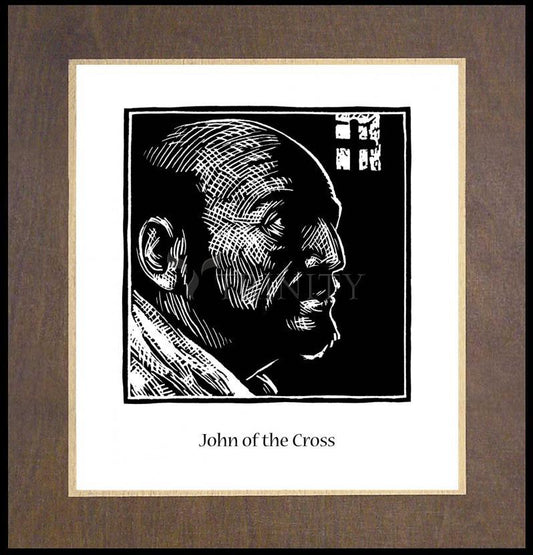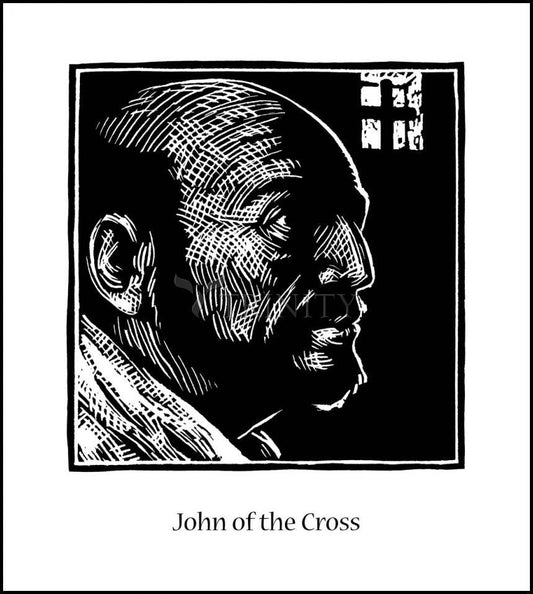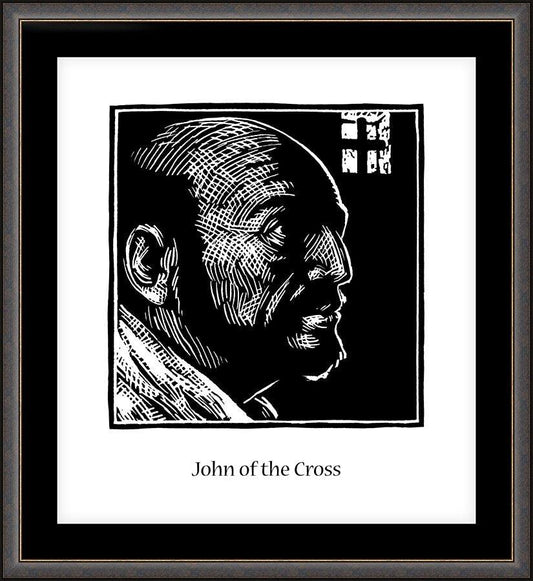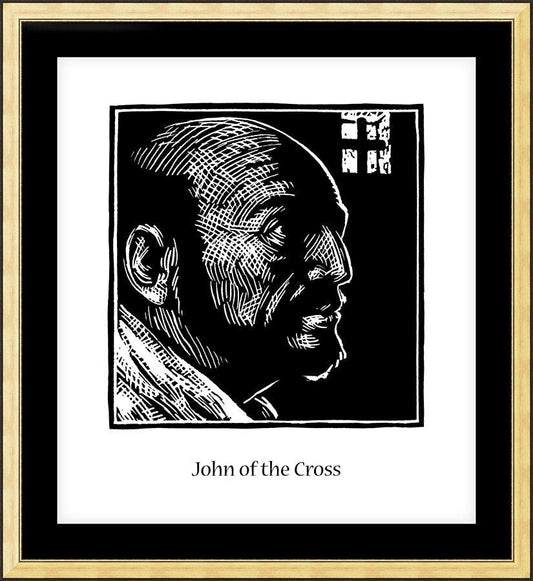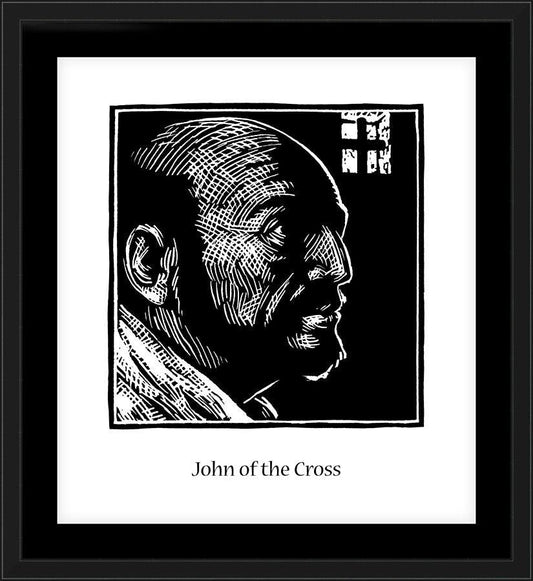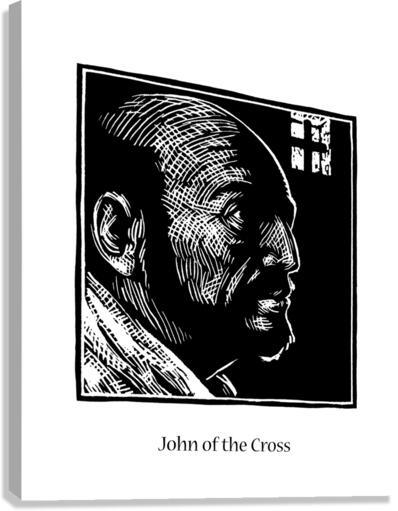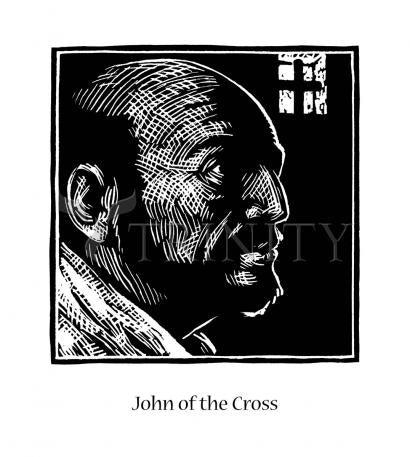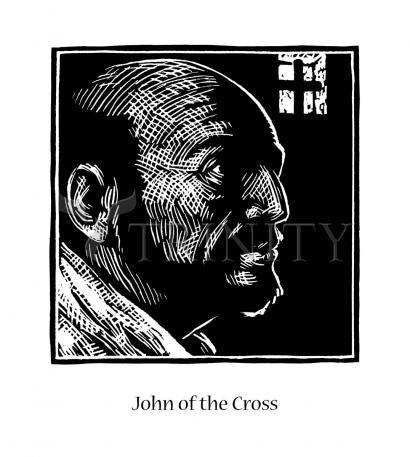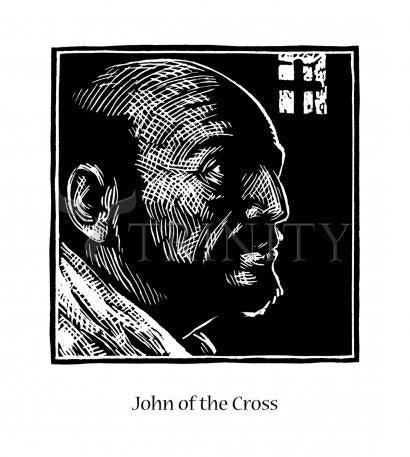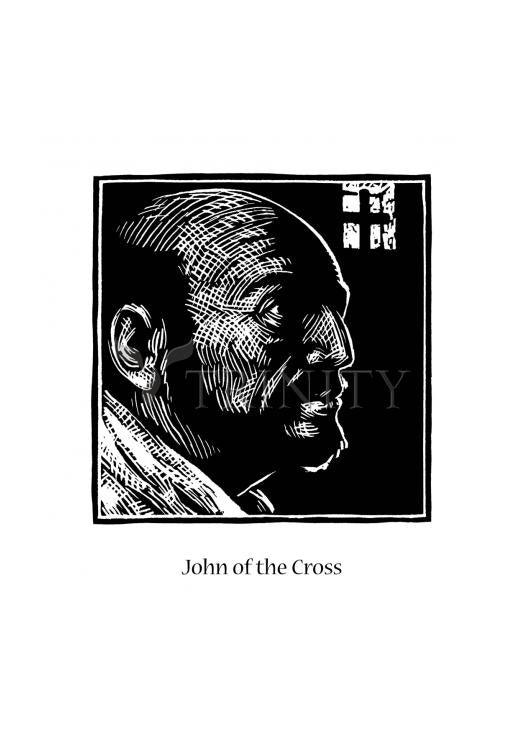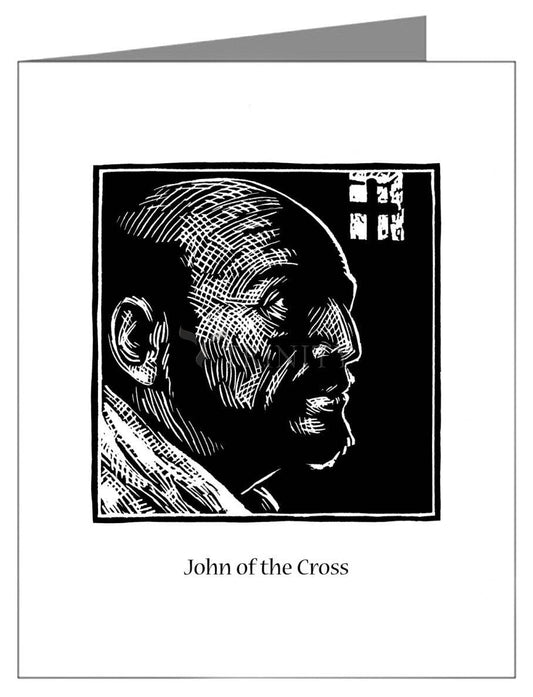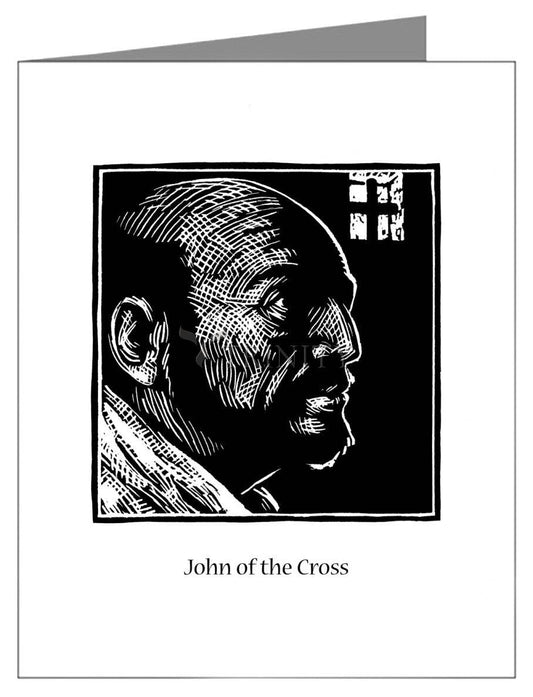John was a founder with St. Teresa of the Discalced Carmelites. He was a doctor of mystic theology. John was born at Hontoveros, Old Castile on 24 June, 1542. He died at Ubeda, Andalusia on 14 Dec., 1591.
John de Yepes was the youngest child of Gonzalo de Yepes and Catherine Alvarez, poor silk weavers of Toledo. He knew from his earliest years the hardships of life. The father, originally of a good family but disinherited on account of his marriage below his rank, died in the prime of his youth. The widow, assisted by her eldest son, was scarcely able to provide the bare necessities. John was sent to the poor school at Medina del Campo, where the family had gone to live, and proved an attentive and diligent pupil. But when apprenticed to an artisan, he seemed incapable of learning anything.
Thereupon the governor of the hospital of Medina took him into his service, and for seven years John
John was a founder with St. Teresa of the Discalced Carmelites. He was a doctor of mystic theology. John was born at Hontoveros, Old Castile on 24 June, 1542. He died at Ubeda, Andalusia on 14 Dec., 1591.
John de Yepes was the youngest child of Gonzalo de Yepes and Catherine Alvarez, poor silk weavers of Toledo. He knew from his earliest years the hardships of life. The father, originally of a good family but disinherited on account of his marriage below his rank, died in the prime of his youth. The widow, assisted by her eldest son, was scarcely able to provide the bare necessities. John was sent to the poor school at Medina del Campo, where the family had gone to live, and proved an attentive and diligent pupil. But when apprenticed to an artisan, he seemed incapable of learning anything.
Thereupon the governor of the hospital of Medina took him into his service, and for seven years John divided his time between waiting on the poorest of the poor, and frequenting a school established by the Jesuits. Already at that early age he treated his body with the utmost rigor -- twice he was saved from certain death by the intervention of the Blessed Virgin.
Anxious about his future life, he was told in prayer that he was to serve God in an order the ancient perfection of which he was to help bring back again. The Carmelites having founded a house at Medina, he there received the habit on 24 February, 1563, and took the name of John of St. Matthias. After profession he obtained leave from his superiors to follow to the letter the original Carmelite rule without the mitigations granted by various popes. He was sent to Salamanca for the higher studies, and was ordained a priest in 1567. At his first Mass he received the assurance that he should preserve his baptismal innocence. But, shrinking from the responsibilities of the priesthood, he determined to join the Carthusians.
However, before taking any further step he made the acquaintance of St. Teresa, who had come to Medina to found a convent of nuns, and who persuaded him to remain in the Carmelite Order and to assist her in the establishment of a monastery of friars carrying out the primitive rule. He accompanied her to Valladolid in order to gain practical experience of the manner of life led by the reformed nuns. A small house having been offered, St. John resolved to try at once the new form of life, although St. Teresa did not think anyone, however great his spirituality, could bear the discomforts of that hovel.
He was joined by two companions, an ex-prior and a lay brother, with whom he inaugurated the reform among friars on 28 Nov., 1568. St. Teresa has left a classical description of the sort of life led by these first Discalced Carmelites. (Book of Foundations, chapters xiii and xiv)
John of the Cross, as he now called himself, became the first master of novices, and laid the foundation of the spiritual edifice which soon was to assume majestic proportions. He filled various posts in different places until St. Teresa called him to Avila as director and confessor to the convent of the Incarnation, of which she had been appointed prioress. He remained there, with a few interruptions, for over five years. Meanwhile, the reform spread rapidly, and, partly through the confusion caused by contradictory orders issued by the general and the general chapter on one hand, and the Apostolic nuncio on the other, and partly through human passion which sometimes ran high, its existence became seriously endangered.
St. John was ordered by his provincial to return to the house of his profession (Medina), and, on his refusing to do so, owing to the fact that he held his office not from the order but from the Apostolic delegate, he was taken prisoner on the night of 3 December, 1577, and carried off to Toledo, where he suffered for more than nine months close imprisonment in a narrow, stifling cell, together with such additional punishment as might have been called for in the case of one guilty of the most serious crimes.
In the midst of his sufferings he was visited with heavenly consolations, and some of his exquisite poetry dates from that period. He made good his escape in a miraculous manner in August, 1578. During the next years he was chiefly occupied with the foundation and government of monasteries at Baeza, Granada, Cordova, Segovia, and elsewhere, but took no prominent part in the negotiations which led to the establishment of a separate government for the Discalced Carmelites.
After the death of St. Teresa (4 Oct.,1582), when the two parties of the Moderates under Jerome Gratian, and the Zelanti under Nicholas Doria struggled for the upper hand, St. John supported the former and shared his fate. For some time he filled the post of vicar provincial of Andalusia. But when Doria changed the government of the order, concentrating all power in the hands of a permanent committee, St. John resisted and supported the nuns in their endeavor to secure the papal approbation of their constitutions.
He drew upon himself the displeasure of the superior, who deprived him of his offices and relegated him to one of the poorest monasteries, where he fell seriously ill. One of his opponents went so far as to go to the monastery gathering materials in order to bring grave charges against him, hoping for his expulsion from the order which he had helped to found.
As his illness increased he was removed to the monastery of Ubeda, where he at first was treated very unkindly, his constant prayer, "to suffer and to be despised", being thus literally fulfilled almost to the end of his life. But at last even his adversaries came to acknowledge his sanctity, and his funeral was the occasion of a great outburst of enthusiasm.
The body, still incorrupt, was removed to Segovia, only a small portion remaining at Ubeda; there was some litigation about its possession. A strange phenomenon, for which no satisfactory explanation has been given, has frequently been observed in connexion with the relics of St. John of the Cross. Francis de Yepes, the brother of the saint, and after him many other persons have noticed the appearance in his relics of images of Christ on the Cross, the Blessed Virgin, St. Elias, St. Francis Xavier, or other saints, according to the devotion of the beholder. The beatification took place on 25 Jan., 1675, the translation of his body on 21 May of the same year, and the canonization on 27 Dec., 1726.
It has been recorded that during his studies St. John particularly relished psychology. This is amply borne out by his writings. He was not what one would term a scholar, but he was intimately acquainted with the "Summa" of St. Thomas Aquinas, as almost every page of his works proves. Holy Scripture he seems to have known by heart, yet he evidently obtained his knowledge more by meditation than in the lecture room. But there is no vestige of influence on him of the mystical teaching of the Fathers, the Aeropagite, Augustine, Gregory, Bernard, Bonaventure,etc., Hugh of St. Victor, or the German Dominican school.
The few quotations from patristic works are easily traced to the Breviary or the "Summa". In the absence of any conscious or unconscious influence of earlier mystical schools, his own system, like that of St. Teresa, whose influence is obvious throughout, might be termed empirical mysticism. They both start from their own experience, St. Teresa avowedly so, while St. John, who hardly ever speaks of himself, "invents nothing" (to quote Cardinal Wiseman), "borrows nothing from others, but gives us clearly the results of his own experience in himself and others. He presents you with a portrait, not with a fancy picture. He represents the ideal of one who has passed, as he had done, through the career of the spiritual life, through its struggles and its victories."
His axiom is that the soul must empty itself of self in order to be filled with God, that it must be purified of the last traces of earthly dross before it is fit to become united with God. In the application of this simple maxim he shows the most uncompromising logic. Supposing the soul with which he deals to be habitually in the state of grace and pushing forward to better things, he overtakes it on the very road leading it, in its opinion to God, and lays open before its eyes a number of sores of which it was altogether ignorant. What he terms the spiritual capital sins.
Not until these are removed (a most formidable task) is it fit to be admitted to what he calls the "Dark Night", which consists in the passive purgation, where God by heavy trials, particularly interior ones, perfects and completes what the soul had begun of its own accord. It is now passive, but not inert, for by submitting to the Divine operation it co-operates in the measure of its power. Here lies one of the essential differences between St. John's mysticism and a false quietism.
The perfect purgation of the soul in the present life leaves it free to act with wonderful energy. In fact it might almost be said to obtain a share in God's omnipotence, as is shown in the marvelous deeds of so many saints. As the soul emerges from the Dark Night it enters into the full moonlight described in the "Spiritual Canticle" and the "Living Flame of Love." St. John leads it to the highest heights, in fact to the point where it becomes a "partaker of the Divine Nature." It is here that the necessity of the previous cleansing is clearly perceived the pain of the mortification of all the senses and the powers and faculties of the soul being amply repaid by the glory which is now being revealed in it.
St. John has often been represented as a grim character. Nothing could be more untrue. He was indeed austere in the extreme with himself, and, to some extent, also with others, but both from his writings and from the depositions of those who knew him, we see in him a man overflowing with charity and kindness, a poetical mind deeply influenced by all that is beautiful and attractive.
The best life of St. John of the Cross was written by JEROME DE SAN JOSÉ (Madrid, 1641)
Born: June 24, 1542 at Fontiveros, Spain
Died: December 14, 1591 at Ubeda
Beatified: January 25, 1675 by Pope Clement X
Canonized: December 27, 1726 by Pope Benedict XIII
Readings:
Never was fount so clear,
undimmed and bright;
From it alone, I know proceeds all light
although 'tis night.
—Saint John of the Cross
Just as we can never separate asceticism from mysticism, so in Saint John of the Cross we find darkness and light, suffering and joy, sacrifice and love united together so closely that they seem at times to be identified.
—Thomas Merton
If you do not learn to deny yourself, you can make no progress in perfection.
—Saint John of the Cross
In detachment, the spirit finds quiet and repose for coveting nothing. Nothing wearies it by elation, and nothing oppresses it by dejection, because it stands in the center of its own humility.
—Saint John of the Cross
divided his time between waiting on the poorest of the poor, and frequenting a school established by the Jesuits. Already at that early age he treated his body with the utmost rigor -- twice he was saved from certain death by the intervention of the Blessed Virgin.
Anxious about his future life, he was told in prayer that he was to serve God in an order the ancient perfection of which he was to help bring back again. The Carmelites having founded a house at Medina, he there received the habit on 24 February, 1563, and took the name of John of St. Matthias. After profession he obtained leave from his superiors to follow to the letter the original Carmelite rule without the mitigations granted by various popes. He was sent to Salamanca for the higher studies, and was ordained a priest in 1567. At his first Mass he received the assurance that he should preserve his baptismal innocence. But, shrinking from the responsibilities of the priesthood, he determined to join the Carthusians.
However, before taking any further step he made the acquaintance of St. Teresa, who had come to Medina to found a convent of nuns, and who persuaded him to remain in the Carmelite Order and to assist her in the establishment of a monastery of friars carrying out the primitive rule. He accompanied her to Valladolid in order to gain practical experience of the manner of life led by the reformed nuns. A small house having been offered, St. John resolved to try at once the new form of life, although St. Teresa did not think anyone, however great his spirituality, could bear the discomforts of that hovel.
He was joined by two companions, an ex-prior and a lay brother, with whom he inaugurated the reform among friars on 28 Nov., 1568. St. Teresa has left a classical description of the sort of life led by these first Discalced Carmelites. (Book of Foundations, chapters xiii and xiv)
John of the Cross, as he now called himself, became the first master of novices, and laid the foundation of the spiritual edifice which soon was to assume majestic proportions. He filled various posts in different places until St. Teresa called him to Avila as director and confessor to the convent of the Incarnation, of which she had been appointed prioress. He remained there, with a few interruptions, for over five years. Meanwhile, the reform spread rapidly, and, partly through the confusion caused by contradictory orders issued by the general and the general chapter on one hand, and the Apostolic nuncio on the other, and partly through human passion which sometimes ran high, its existence became seriously endangered.
St. John was ordered by his provincial to return to the house of his profession (Medina), and, on his refusing to do so, owing to the fact that he held his office not from the order but from the Apostolic delegate, he was taken prisoner on the night of 3 December, 1577, and carried off to Toledo, where he suffered for more than nine months close imprisonment in a narrow, stifling cell, together with such additional punishment as might have been called for in the case of one guilty of the most serious crimes.
In the midst of his sufferings he was visited with heavenly consolations, and some of his exquisite poetry dates from that period. He made good his escape in a miraculous manner in August, 1578. During the next years he was chiefly occupied with the foundation and government of monasteries at Baeza, Granada, Cordova, Segovia, and elsewhere, but took no prominent part in the negotiations which led to the establishment of a separate government for the Discalced Carmelites.
After the death of St. Teresa (4 Oct.,1582), when the two parties of the Moderates under Jerome Gratian, and the Zelanti under Nicholas Doria struggled for the upper hand, St. John supported the former and shared his fate. For some time he filled the post of vicar provincial of Andalusia. But when Doria changed the government of the order, concentrating all power in the hands of a permanent committee, St. John resisted and supported the nuns in their endeavor to secure the papal approbation of their constitutions.
He drew upon himself the displeasure of the superior, who deprived him of his offices and relegated him to one of the poorest monasteries, where he fell seriously ill. One of his opponents went so far as to go to the monastery gathering materials in order to bring grave charges against him, hoping for his expulsion from the order which he had helped to found.
As his illness increased he was removed to the monastery of Ubeda, where he at first was treated very unkindly, his constant prayer, "to suffer and to be despised", being thus literally fulfilled almost to the end of his life. But at last even his adversaries came to acknowledge his sanctity, and his funeral was the occasion of a great outburst of enthusiasm.
The body, still incorrupt, was removed to Segovia, only a small portion remaining at Ubeda; there was some litigation about its possession. A strange phenomenon, for which no satisfactory explanation has been given, has frequently been observed in connexion with the relics of St. John of the Cross. Francis de Yepes, the brother of the saint, and after him many other persons have noticed the appearance in his relics of images of Christ on the Cross, the Blessed Virgin, St. Elias, St. Francis Xavier, or other saints, according to the devotion of the beholder. The beatification took place on 25 Jan., 1675, the translation of his body on 21 May of the same year, and the canonization on 27 Dec., 1726.
It has been recorded that during his studies St. John particularly relished psychology. This is amply borne out by his writings. He was not what one would term a scholar, but he was intimately acquainted with the "Summa" of St. Thomas Aquinas, as almost every page of his works proves. Holy Scripture he seems to have known by heart, yet he evidently obtained his knowledge more by meditation than in the lecture room. But there is no vestige of influence on him of the mystical teaching of the Fathers, the Aeropagite, Augustine, Gregory, Bernard, Bonaventure,etc., Hugh of St. Victor, or the German Dominican school.
The few quotations from patristic works are easily traced to the Breviary or the "Summa". In the absence of any conscious or unconscious influence of earlier mystical schools, his own system, like that of St. Teresa, whose influence is obvious throughout, might be termed empirical mysticism. They both start from their own experience, St. Teresa avowedly so, while St. John, who hardly ever speaks of himself, "invents nothing" (to quote Cardinal Wiseman), "borrows nothing from others, but gives us clearly the results of his own experience in himself and others. He presents you with a portrait, not with a fancy picture. He represents the ideal of one who has passed, as he had done, through the career of the spiritual life, through its struggles and its victories."
His axiom is that the soul must empty itself of self in order to be filled with God, that it must be purified of the last traces of earthly dross before it is fit to become united with God. In the application of this simple maxim he shows the most uncompromising logic. Supposing the soul with which he deals to be habitually in the state of grace and pushing forward to better things, he overtakes it on the very road leading it, in its opinion to God, and lays open before its eyes a number of sores of which it was altogether ignorant. What he terms the spiritual capital sins.
Not until these are removed (a most formidable task) is it fit to be admitted to what he calls the "Dark Night", which consists in the passive purgation, where God by heavy trials, particularly interior ones, perfects and completes what the soul had begun of its own accord. It is now passive, but not inert, for by submitting to the Divine operation it co-operates in the measure of its power. Here lies one of the essential differences between St. John's mysticism and a false quietism.
The perfect purgation of the soul in the present life leaves it free to act with wonderful energy. In fact it might almost be said to obtain a share in God's omnipotence, as is shown in the marvelous deeds of so many saints. As the soul emerges from the Dark Night it enters into the full moonlight described in the "Spiritual Canticle" and the "Living Flame of Love." St. John leads it to the highest heights, in fact to the point where it becomes a "partaker of the Divine Nature." It is here that the necessity of the previous cleansing is clearly perceived the pain of the mortification of all the senses and the powers and faculties of the soul being amply repaid by the glory which is now being revealed in it.
St. John has often been represented as a grim character. Nothing could be more untrue. He was indeed austere in the extreme with himself, and, to some extent, also with others, but both from his writings and from the depositions of those who knew him, we see in him a man overflowing with charity and kindness, a poetical mind deeply influenced by all that is beautiful and attractive.
The best life of St. John of the Cross was written by JEROME DE SAN JOSÉ (Madrid, 1641)
Born: June 24, 1542 at Fontiveros, Spain
Died: December 14, 1591 at Ubeda
Beatified: January 25, 1675 by Pope Clement X
Canonized: December 27, 1726 by Pope Benedict XIII
Readings:
Never was fount so clear,
undimmed and bright;
From it alone, I know proceeds all light
although 'tis night.
—Saint John of the Cross
Just as we can never separate asceticism from mysticism, so in Saint John of the Cross we find darkness and light, suffering and joy, sacrifice and love united together so closely that they seem at times to be identified.
—Thomas Merton
If you do not learn to deny yourself, you can make no progress in perfection.
—Saint John of the Cross
In detachment, the spirit finds quiet and repose for coveting nothing. Nothing wearies it by elation, and nothing oppresses it by dejection, because it stands in the center of its own humility.
—Saint John of the Cross



